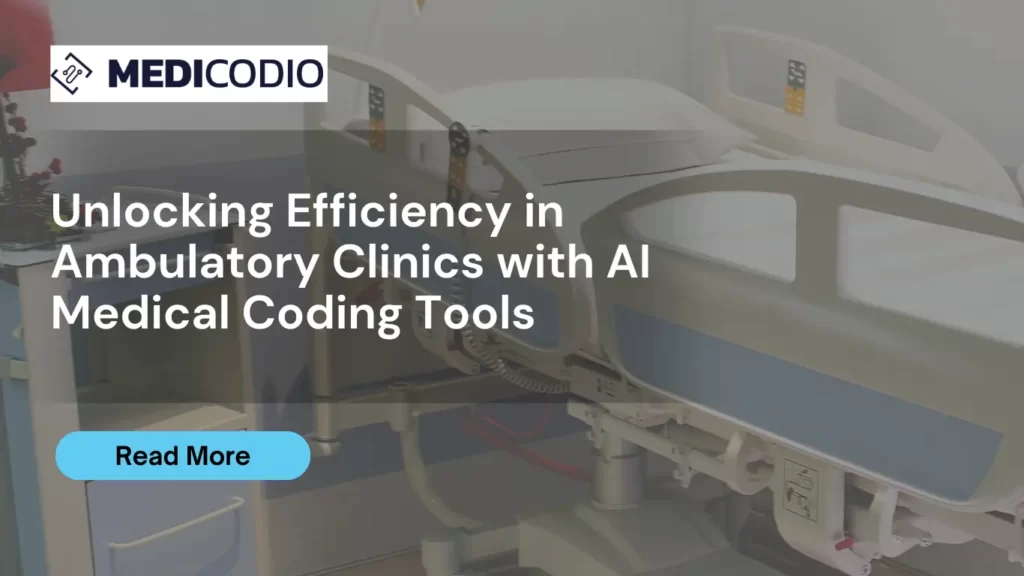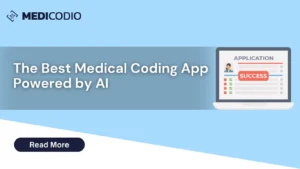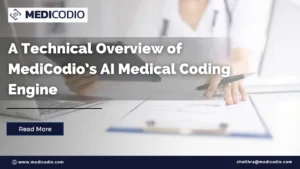In the fast-paced environment of ambulatory clinics, the need for accurate and swift medical coding has become increasingly crucial. Recent surveys and statistics underline the significance of embracing technological advancements, particularly in the form of AI-driven solutions, to streamline medical coding processes. According to a survey conducted by the American Health Information Management Association (AHIMA), approximately 80% of medical bills contain errors due to manual coding, leading to billing discrepancies, claim denials, and revenue loss. This staggering figure emphasizes the pressing need for innovative solutions to optimize medical coding accuracy and efficiency.
Ambulatory clinics, often characterized by their high patient volumes and time-sensitive nature, face numerous challenges associated with medical coding. Manual coding processes are prone to human errors, resulting in incorrect billing, delayed payments, and compliance issues. Moreover, the complexity of healthcare coding systems, such as the International Classification of Diseases (ICD) and Current Procedural Terminology (CPT), poses a significant hurdle for healthcare professionals in accurately assigning the appropriate codes to diagnoses and procedures.
Difference between Ambulatory clinics and Outpatient Clinics
Ambulatory clinics and outpatient clinics are often used interchangeably, but they do have nuanced differences in their meanings.
Ambulatory Clinics:
- Definition: Ambulatory clinics refer to healthcare facilities where patients receive medical care on an outpatient basis, meaning they visit for diagnosis, treatment, or consultation and then leave without staying overnight.
- Scope: These clinics cover a wide range of medical services, including diagnostic tests, routine check-ups, minor surgeries, preventive care, and chronic disease management.
- Settings: Ambulatory clinics can be located within hospitals, medical centers, or operate as standalone facilities.
- Focus: They may specialize in specific areas such as women’s health, pediatrics, orthopedics, etc.
- Accessibility: Often more accessible and convenient for patients due to their locations and focus on non-emergency care.
Outpatient Clinics:
- Definition: Outpatient clinics, similar to ambulatory clinics, provide medical services to patients who do not require hospitalization and can return home on the same day.
- Scope: They offer various medical services and treatments without the need for overnight stays, catering to a wide array of healthcare needs.
- Settings: Outpatient clinics can be part of hospitals, medical centers, or exist as separate facilities.
- Focus: Like ambulatory clinics, they might specialize in specific medical fields or offer general healthcare services.
- Accessibility: Aimed at providing accessible healthcare services without the need for hospital admission, usually for less severe conditions or routine medical care.
Key Differences:
- Terminology: The term “ambulatory clinic” emphasizes the idea of patients walking in and out for care, while “outpatient clinic” emphasizes that patients are not admitted to a hospital for care.
- Usage: Ambulatory clinics might sometimes refer to a broader concept that encompasses outpatient clinics along with other non-hospital-based care facilities.
In essence, both ambulatory and outpatient clinics share the core concept of providing medical services to patients who do not require overnight stays. The distinction between them may vary in usage within different healthcare systems or contexts, but they generally refer to similar outpatient care facilities.
The Right Technology
The implementation of AI-powered medical coding tools has emerged as a compelling solution to address these challenges. The integration of artificial intelligence in healthcare, specifically in the form of medical coding tools, offers a paradigm shift in streamlining coding processes, enhancing accuracy, and optimizing operational efficiency.
Introducing MediCodio’s CODIO, an advanced AI medical coding tool designed to revolutionize the way ambulatory clinics manage their medical coding tasks. CODIO harnesses the power of machine learning algorithms and natural language processing to automate and optimize the coding workflow, significantly reducing the burden on healthcare professionals while ensuring precision in coding practices.
One of the primary advantages of CODIO lies in its ability to swiftly process vast amounts of medical data and clinical documentation. Through advanced algorithms, CODIO comprehensively analyzes patient records, extracting relevant information and generating accurate medical codes for diagnoses, procedures, and treatments. This not only expedites the coding process but also minimizes the likelihood of errors that are prevalent in manual coding.
Moreover, CODIO operates as a learning system, continuously improving its accuracy and efficiency through machine learning. As it encounters new data and coding scenarios, the AI algorithm adapts and refines its coding patterns, thereby enhancing its performance over time. This adaptive learning capability ensures that the tool stays updated with evolving coding guidelines and healthcare regulations, aligning with the dynamic nature of the healthcare industry.
The user-friendly interface of CODIO makes it accessible and intuitive for healthcare professionals, requiring minimal training for adoption. Its integration into existing electronic health record (EHR) systems further facilitates seamless workflow integration within ambulatory clinics. Healthcare providers can rely on CODIO to expedite the coding process without disrupting their routine practices, thereby improving productivity and allowing them to focus more on patient care.
Furthermore, the implementation of CODIO brings forth tangible benefits for ambulatory clinics. By significantly reducing coding errors and ensuring accurate documentation, clinics using CODIO experience a decrease in claim denials and billing discrepancies. This leads to expedited reimbursements, enhanced revenue cycles, and improved financial health for healthcare facilities.
Additionally, the utilization of AI-driven coding tools like CODIO optimizes resource allocation within ambulatory clinics. By automating repetitive coding tasks, healthcare professionals can allocate their time and expertise toward more critical aspects of patient care, enhancing overall operational efficiency and patient satisfaction.
The compliance and audit capabilities embedded within CODIO provide an added layer of assurance for clinics in adhering to regulatory standards. The tool conducts real-time checks to ensure coding accuracy and compliance with coding guidelines, minimizing the risk of non-compliance penalties and audits.
In conclusion, the incorporation of AI medical coding tools like CODIO presents a transformative opportunity for ambulatory clinics to overcome the challenges associated with manual coding processes. By leveraging the capabilities of artificial intelligence, clinics can achieve greater accuracy, efficiency, and compliance in their medical coding practices. As the healthcare landscape continues to evolve, embracing innovative solutions like CODIO becomes imperative for clinics aiming to optimize their coding workflows and deliver superior patient care.





